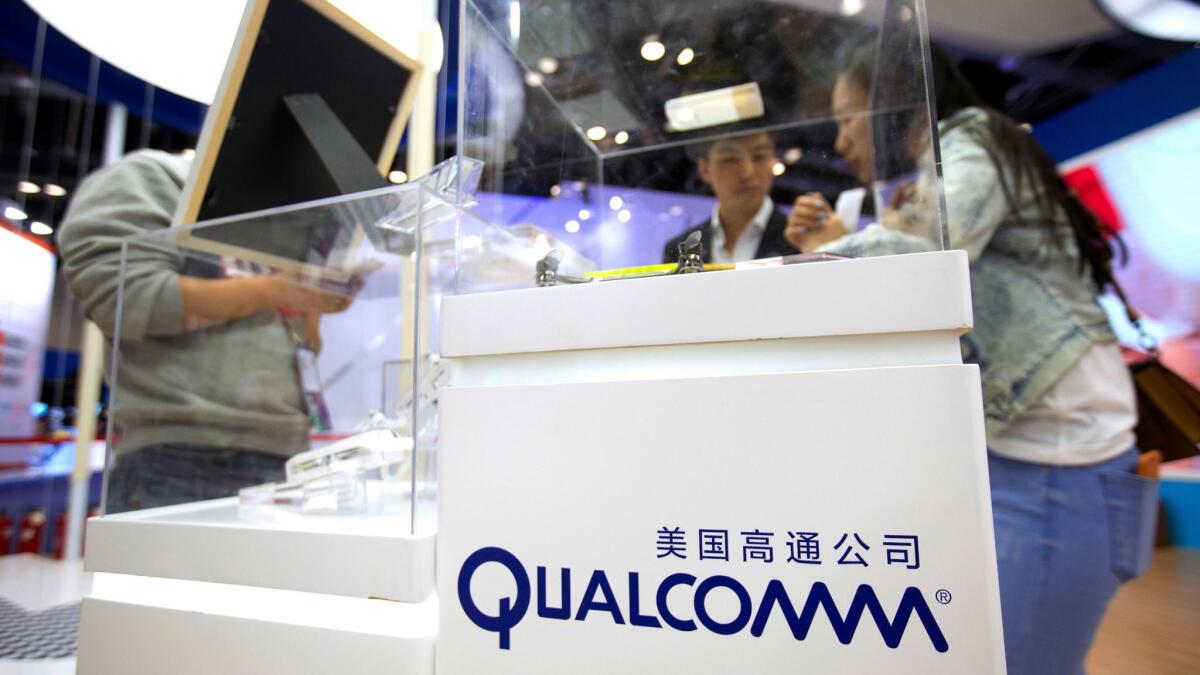What Apple and Qualcomm are really fighting about

Back in 1990 when Qualcomm was a start-up, it was spending so much on a new approach to cellular communications that it struggled to make payroll.
So the San Diego firm began peddling its 50 patents to mobile phone and network gear makers. It negotiated upfront fees to fund research, as well as an ongoing patent royalty should its technology ever be used in products.
Companies did use Qualcomm’s technology. And in a big way.
Qualcomm’s inventions are now under the hood of every 3G/4G smartphone. They power faster download and upload speeds and have reduced static and interference, given batteries a longer life, made auto lock and airplane mode possible, and the list goes on. Qualcomm’s patent licensing arm is a $7.7-billion juggernaut, with 130,000 patents issued and pending. Its licensing business model helped cement Qualcomm as the research and development engine for the mobile industry.
And now Qualcomm is in Apple’s crosshairs over how much it charges for its inventions. In January, Apple sued Qualcomm, cutting off royalty payments. Among other things, it contends Qualcomm is illegally gouging Apple on patent fees and collecting royalties on innovations it had nothing to do with.
Anti-monopoly regulators in the U.S. and South Korea allege Qualcomm has concocted a scheme that leverages its dominance as a cellular modem chip supplier to overcharge for patent licenses and hamstring competitors. Qualcomm believes these charges were instigated by Apple.
Monopoly regulators in Europe and Taiwan are investigating. Tech giants Intel and Samsung have lined up behind Apple. So have technology trade groups that count Google and Microsoft as members.
Qualcomm counters that its fundamental cellular technologies breathe life into mobile phones. Without them, a $700 iPhone is a glorified iPod Touch.
For this technology that enables high-speed, ubiquitous connectivity, Apple was paying on average $10 per iPhone.
For consumers, this battle might not amount to much — a settlement that slightly lowers costs for Apple and perhaps other smartphone makers.
But if Apple succeeds in striking a blow to Qualcomm’s licensing business, it could create a funding void for Qualcomm’s R&D machine, which created many of the advances in 3G/4G communications to date and is now pushing hard to invent next-generation 5G technologies.
“In patent law, we always look not just at the short term but also the long term,” said Jonathan Barnett, a professor at USC’s Gould School of Law. “If you don’t have enough compensation flowing up to the innovator, their incentive to do research and development is reduced, and that could make consumers worse off” over time.
This complex fight is being waged under the canopy of contract law, patent law and antitrust rules. It pits two very different business models for innovation against each other. It’s hard to predict the outcome. But it appears both sides are preparing for a long war.
Innovation house
There’s a bit of black magic in wireless, and Qualcomm’s sorcery soars in getting more out of the invisible airwaves that carry data between smartphones and cellular networks.
“To be able to throw much more data across that narrow bandwidth, to operate along multiple paths without interference, those are the kind of things that we and only a couple other companies have spent their resources on,” said Don Rosenberg, Qualcomm’s general counsel.
Qualcomm’s breakthrough was a 2G/3G standard called Code Division Multiple Access. It enabled cellular operators to add millions of subscribers to their networks at lower cost and with fewer dropped calls.
Qualcomm also led the way in today’s fourth-generation 4G LTE, which improved speeds and airwave efficiency even more. During the recession, it spent heavily on LTE technology while the rest of the industry licked its wounds.
“There wouldn’t have been LTE, really, until 2014 without Qualcomm,” said Mike Walkley, an analyst with financial services firm Canaccord Genuity. “Fast-forward and part of Apple’s complaint is that Qualcomm had a virtual monopoly on LTE from 2010 to 2014. But on the flip side, if there’s no LTE, there’s no great iPhone smartphone market.”
Qualcomm continues to push the mobile envelope, serving up gigabit-per-second peak download speeds on its latest LTE chips.
“You have one carrier a week making announcements that they’re going to have Gigabit LTE, and Qualcomm is the only silicon that does it,” said industry analyst Patrick Moorhead of Moor Insights & Strategy.
Chips and patents
Qualcomm has two businesses. It licenses its large portfolio of patents to device makers. And it also sells semiconductors that power mobile devices, including cellular modems that link smartphones to cell networks.
While the semiconductor business generates most of Qualcomm’s revenue, the licensing arm accounts for three-quarters of its profit.
Qualcomm pours a big chunk of licensing revenue back into R&D — about $5 billion a year — to invent next-generation mobile technologies.
Essential patents
Consumers are able to use gadgets from different manufacturers seamlessly because technology inside the devices works together. That happens because of standard essential patents, which the industry has agreed to include to ensure interoperability.
Qualcomm, Nokia, Ericsson and Samsung are among the big standard essential patent holders in cellular. They have a lot of negotiating power over device makers, since their technology is needed for, say, a text from an Android phone to be read on an iPhone.
So in exchange for their technology being included in the standard, they promise to license on “fair, reasonable and non-discriminatory” terms.
Such terms are typically hammered out in negotiations between device makers and patent holders. When talks break down, the dispute ends up in court.
The business of innovation
Companies use two main blueprints to earn a return on research and development. Many firms, including Apple, keep patented inventions for themselves. They’re not available for licensing. They give the company a competitive advantage and raise barriers for rivals to enter the market.
Qualcomm does the opposite. When it invents mobile technologies, it makes them available to the entire industry for a price.
Qualcomm’s model fosters competition in handsets, said Richard Windsor, a longtime Nomura Securities analyst who now runs Radio Free Mobile, a technology research publisher. New companies can enter the market without making a huge R&D investment in cellular.
But there are wrinkles in the way Qualcomm gets paid for its intellectual property that have been controversial.
The company treats its chips and patents as separate products. When smartphone makers buy cellular modems, the price does not include the value of Qualcomm’s intellectual property.
Instead, Qualcomm gets paid for its intellectual property through patent licenses with phone makers.
This is unusual. Most product companies, including those that license patents, recover R&D investments through product sales.
Qualcomm does it differently for a couple of reasons. The key one is that its inventions, which underlie mobile communications, are implemented well beyond a single product in the phone such as the modem chip.
Solving the vexing technical puzzles in wireless requires systemswide technologies, the company says. Some of the puzzle is solved in the modem, but the rest comes together in other places such as the phone’s antennas, in cell towers and across the cellular network.
Qualcomm says its patent portfolio covers these systemwide approaches. That’s why it makes sense to license patents at the handset level. The cellular industry grew up this way. Nokia, Ericsson, Samsung, Huawei and ZTE also collect device-level royalties.
Apple and others argue that Qualcomm’s technology is mostly encased in the modem, and its business model is structured to allow it to get paid more than its inventions merit.
The bite of Apple
Apple doesn’t shy away from litigation. It has been in legal wrangles with Samsung, Motorola, Nokia and others over patents.
While there’s much bombastic language flying around in these lawsuits, the key allegations are that Qualcomm is engaged in a monopolistic scheme to corral exorbitant royalties and hurt competitors.
Apple says Qualcomm’s unfair business practices allow it to achieve “an order of magnitude” higher royalties than all other cellular patent holders combined.
Smartphones have evolved into complex, multi-function computers with advanced cameras, hefty processing power and significant memory. Yet Qualcomm continues to charge the same royalty rate that it did when phones were primarily used for voice and the modem was more critical, Apple says.
Qualcomm has a dominant market share in top-tier cellular modem chips, so smartphone makers cave to Qualcomm’s licensing demands, according to the lawsuits from Apple and regulators. They acquiesce to inflated rates and don’t challenge the strength of Qualcomm’s patents.
Qualcomm refuses to grant licenses to rival modem makers, which Apple and others contend furthers its scheme to overcharge for royalties.
Licensing other chip makers could pave a path toward chip-level patent agreements under current case law. It also could create a spider web of complicated negotiations and disputes, given that the workings of today’s smartphones involve an estimated 250,000 patents.
“They supply us with a single connectivity component but for years have been demanding a percentage of the total cost of our products — effectively taxing Apple’s innovation,” Apple said in a statement.
Counterpunching
Qualcomm’s strong patent position does open the door for potential abuse. But is that occurring?
Qualcomm says it has inked more than 300 license agreements over two decades that establish the market value of its intellectual property.
The rate for Qualcomm’s portfolio of patents tops out at 5% of the sales price of the device, but smartphone makers usually pay less these days. They can reduce the rate by paying a lump-sum amount upfront. There’s a cap on the maximum dollar amount charged per phone.
Today, smartphone makers are paying $5 to $6 per phone on average for using Qualcomm patents, said Walkley, the Canaccord Genuity analyst.
According to Qualcomm, it’s false to claim smartphone makers don’t push back in licensing negotiations. Disagreements and re-negotiations pop up often. Sometimes device makers stop paying royalties when talks break down.
Qualcomm says it has never cut off chip supply to a licensee during these disputes.
The company says it is not required to license rival chip makers under its commitment to the cellular standard setting organization. These competitors are free to sell chips without paying a license fee to Qualcomm for the same reason that Qualcomm doesn’t recover the cost of its intellectual property when it sells chips: The patents read on the entire phone. Qualcomm is already getting paid for its intellectual property rights through its license agreements with handset makers.
Messing with success
This legal fight is playing out as the smartphone market inches toward saturation, with slowing growth. That’s likely to continue until 5G technologies spark the next upgrade cycle in 2019-20.
But it’s a market where Apple has been one of the biggest winners. The company has sold nearly 1.2 billion iPhones, ringing up $775 billion in sales and $250 billion in profits over the last decade, according to Counterpoint Research.
Studies suggest smartphone prices have declined — when adjusted for computing power and functionality of the device — since the inception of the industry, said Barnett, the USC law professor.
“What that is telling you is the standard setting process is working as it was intended to,” he said.
mike.freeman@sduniontribune.com
ALSO
Apple breaks its silence on net neutrality, saying: Don’t repeal the rules
Riot Games and Annenberg Foundation bring classes on making video games to L.A. schools
Whisper loses high-profile board members as co-founders seek to regain control
More to Read
Inside the business of entertainment
The Wide Shot brings you news, analysis and insights on everything from streaming wars to production — and what it all means for the future.
You may occasionally receive promotional content from the Los Angeles Times.










